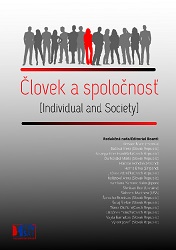Psychological correlates and predictors of problematic smartphone use among female university students during the Covid-19 pandemic
Psychological correlates and predictors of problematic smartphone use among female university students during the Covid-19 pandemic
Author(s): Marek Malůš, Dorota CiencialováSubject(s): Gender Studies, Media studies, Higher Education , Social psychology and group interaction, Clinical psychology, Health and medicine and law, ICT Information and Communications Technologies
Published by: SAV - Slovenská akadémia vied - Spoločenskovedný ústav SAV
Keywords: Smartphones; Social networks; Problematic smartphone use; Problematic use of mobile phones; Smartphone addiction; Fear of missing out; COVID-19;
Summary/Abstract: Research objective: Increasing interest in new technological advances, in this case smartphones, brings about an increasing scale of their usage, which in many cases exceeds the boundaries of common use and becomes problematic. The period of restrictions caused by COVID-19 is a variable causing an increase of social media usage across age groups. Based on a theoretical analysis, we have defined the main objective of a questionnaire study, which is to measure the way and size of problematic usage of smartphones among female university undergraduates, including the attributes of phobic and addictive usage. In order to cover the matter in a wider context, another objective of this study emerged, which was to explore the connection between the size and method of smartphone use and some other concepts, such as the fear of missing out and satisfaction with life. The third objective we introduced was a regression model of observed variables with problematic smartphone use behaviour as a dependant variable. Method: The research study comprised 988 female undergraduates in the age range of 19 – 56 (M = 22.8; SD = 5.31; IQR = 3) Data were collected between January and March 2021 using the platform Google Forms, combining random selection and Snowball Techniques. Smartphone Usage Scale (SUS) containing 11 items was used to map the usage frequency of particular smartphone functions. Another method used was the scale Problematic Use of Mobile phones with 20 items to determine the size of problematic smartphone usage, in this case of phobic character. The new phenomenon associated with excessive usage of smartphones, Fear of Missing Out (FoMO), was determined by the same scale containing 10 items. Problematic smartphone usage is also connected with the trait anxiety, which was measured by the second scale of State-Trait Anxiety Inventory (STAI X-2). In order to cover the biggest possible spectrum of digital behaviour, we also used the methods of addictive character. The method Smartphone Addiction Scale (SAS) is a questionnaire discovering problematic smartphone usage and the questionnaire Internet Addiction Test (IAT), which aims to measure the characteristics connected with excessive Internet usage. Descriptive analysis, correlation analysis and linear regression were conducted in IBM SPSS 26. Results: The most commonly used smartphone functions were text/instant messaging services (M = 4.74, SD = .525) and social network applications (M = 4.33, SD = .864), followed by the category music/podcasts/radio (M = 3.91, SD = 1.142). The three most frequently used social network applications were Facebook (76.1%), Instagram (75.5%) and Messenger (34.1%). Three strongest correlations were measured at nomophobia (measured by PUMP) and smarthphone addiction (measured by SAS) with a very strong correlation r = .819. Smartphone and Internet addictions (measured by IAT) showed strong correlation r = .776 and nomophobia and Internet addiction showed strong correlation, as well r = .771. Multiple linear regression was calculated to predict problematic smartphone use behaviour (SAS) based on scores of smartphone usage (SUS), problematic use of mobile phones (PUMP), internet addiction (IAT), fear of missingut (FoMo), state anxiety (STAI-X1), trait anxiety (STAI-X2) and satisfaction with life (SWLS). A significant regression equation was found (F (7.941) = 380.660, p < .001) with R2 = .740. This model predicts 74% of smartphone addiction measured by Smartphone Addiction Scale. Significant predictors of problematic smartphone use behaviour are smartphone usage (β = .065, p < .001, CI [.196, .628] , problematic use of mobile phones (β = .503, p < .001, CI [1.130, 1.403]), internet addiction (β = .343, p < .001, CI [ .705, .962]), and fear of missing out (β = .085, p < .001, CI [ .247, .690]). Discussion: All in all, the participants of our study mostly reached the scores in the range of common usage. In conformity with foreign studies, the results of size and ways of smartphone use show dominance in chatting and communication applications among female university undergraduates. In the given research sample, the leading social network applications were those of Facebook. The application TikTok does not correspond with the foreign trends in our study group, which might be explained by the absence of adolescent participants and the formulation of the given question. The age and satisfaction with life correlate negatively with the observed variables, and appear to be certain protective factors against problematic use of smartphones and social networks. State anxiety and trait anxiety show positive correlations with the observed variables of smartphone and network usage. However, as predictors of problematic smartphone use behaviour, they were not significant. The strongest predictors showed to be problematic use of mobile phones (PUMP) and internet addiction (IAT). The limitations of this study were the absence of representativeness of the research sample, the collection of data during pandemic COVID-19, and the solely, self-evaluation methods.
Journal: Človek a spoločnosť
- Issue Year: 24/2021
- Issue No: 3
- Page Range: 1-19
- Page Count: 19
- Language: English

